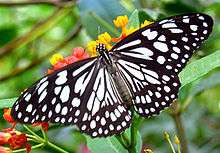Ideopsis vulgaris
| Blue glassy tiger | |
|---|---|
 | |
| Scientific classification | |
| Kingdom: | Animalia |
| Phylum: | Arthropoda |
| Class: | Insecta |
| Order: | Lepidoptera |
| Family: | Nymphalidae |
| Genus: | Ideopsis |
| Species: | I. vulgaris |
| Binomial name | |
| Ideopsis vulgaris (Butler, 1874) | |
| Synonyms | |
| |
Ideopsis vulgaris, the blue glassy tiger, is a butterfly that belongs to the crows and tigers, that is, the danaid group of the brush-footed butterflies family.
Description
Ideopsis vulgaris has a wingspan reaching 70–80 millimetres (2.8–3.1 in). This butterfly is quite similar to the dark glassy tiger (Parantica agleoides). A transverse black bar in the forewing cell, cutting through one of the white streaks, distinguishes the blue glassy tiger from the other one. As other milkweed butterfly it is mimicked by Chilasa clytia (Papilionidae).
Upperside: black, the dorsal margin of hindwing broadly cinereous; both wings with the following subhyaline bluish-white streaks and spots.
Forewing: a short streak along dorsal margin, two broad streaks united at base in interspace 1, the upper one curved, a broad streak in cell with an outwardly indented detached spot beyond it in apex, a slender costal streak, two large discal spots inwardly pointed, outwardly truncate, three elongate spots beyond apex of cell and four or five elongate preapical spots beyond them, finally a subterminal and a terminal series of spots decreasing in size towards apex of wing.
Hindwing: elongate streaks in interspaces 1 a and 1 b, two in interspace 1, two in cell with a short slender streak-obliquely between their apices, shorter streaks radiating outwards in interspaces 2–6, a sub-terminal series of small spots and a terminal row of dots beyond.
Underside: similar, the markings better defined. Antennae black, palpi black above, bluish white below; head and thorax black, spotted with bluish white; abdomen brown above, sullied white below. Male without any special sex-marks on the wings.[1]
Race exprompta, Butler (Sri Lanka). Closely resembles D. vulgaris Butler, but has all the markings much broader, the apical spot in cell of forewing outwardly less emarginate; on the hindwing interspaces 1 a and 1 b are entirely filled with the white streak, while the short slender streak lying between the apices of the streaks in the cell coalesces with the lower one.
Race nicobarica, W.-M. & de N. (Nicobar Islands). Like the preceding race, but the subhyaline markings still broader and somewhat blurred. Upperside: forewing: the whole basal two-thirds of interspace 1 bluish white, enclosing a fine longitudinal black line; streak in discoidal cell vary broad, occasionally produced to the apical spot in the cell. Hindwing: the black in interspace 1 reduced to a mere streak; cell entirely bluish white, traversed longitudinally by a faint black forked line. In the solitary specimen of the male in the collection of the British Museum this line is entirelyabsent.
Larvae feed on Gymnema species (Asclepiadaceae), Tylophora fleuxosa, Tylophora tenuissima (Apocynaceae) and is thus distasteful to birds.[2]
Distribution
This species can be found in India, Singapore, Thailand, Laos, Vietnam, Hainan, South Burma - Sundaland, Sumatra, Java, Lesser Sunda Islands - Alor, Borneo – Palawan.[2]
Habitat
These butterflies occur at the edge of forests or plantations and in the coastal mangrove areas.
Subspecies
- Ideopsis vulgaris contigua Talbot, 1939 – (Thailand, Laos, Vietnam)
- Ideopsis vulgaris macrina (Fruhstorfer, 1904) – (Sumatra)
Similar species
- Blue tiger (Tirumala limniace)
- Dark glassy tiger (Parantica agleoides)
See also
References
- ↑ Bingham, C.T. (1905). The Fauna of British India, Including Ceylon and Burma Butterflies. 1 (1st ed.). London: Taylor and Francis, Ltd.
- 1 2 Ideopsis vulgaris, Funet.fi
External links
 Media related to Ideopsis vulgaris at Wikimedia Commons
Media related to Ideopsis vulgaris at Wikimedia Commons Data related to Ideopsis at Wikispecies
Data related to Ideopsis at Wikispecies- Sri Lanka Wild Life Information Database
- Butterflies Circle
- Butterflies in Indo-Chine I. v. contigua
- Butterflies in Indo-Chine I.v. macrina
- Brower, Andrew V.Z. (2010). Glassy Tigers